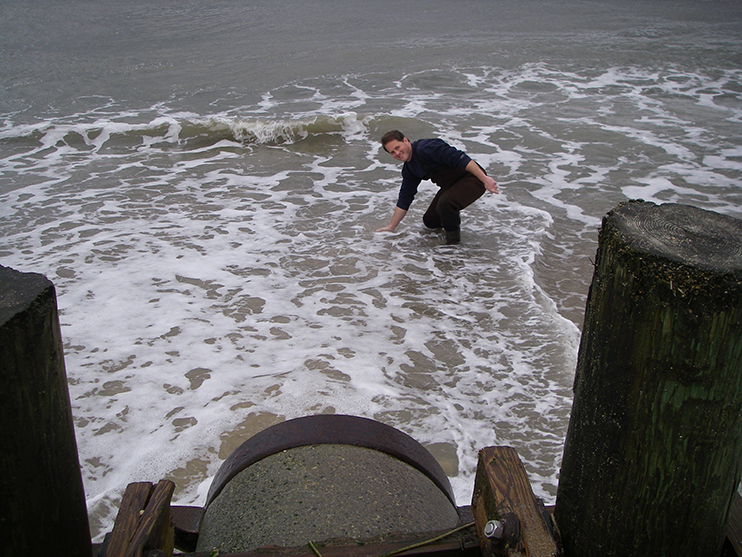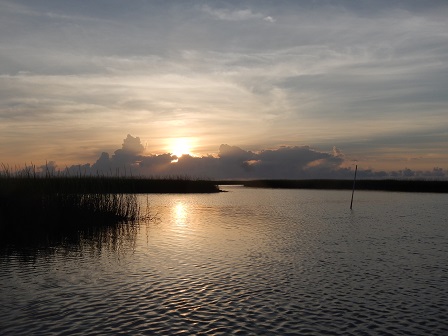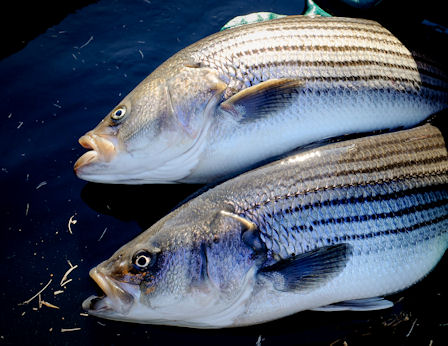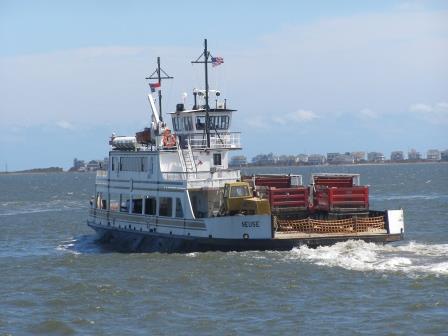Back To The Future: Revisiting Cisterns And Rain Gardens

Fifteen hundred years ago, the Byzantine Turks built a huge covered cistern underneath Constantinople. The Yerebatan Sarayi or “Sunken Palace” survives to this day, supported by 336 Corinthian columns, each over 30 feet tall. The grand cistern stored water for the Emperor Justinian’s nearby palace — very convenient during long sieges.
For similar reasons, Civil War soldiers at Fort Macon, near Atlantic Beach, N.C., pulled water from cisterns located under the stairs. “Rainwater filtered through the soil above the casemates, passed through zinc pipes in the walls and flowed through underground channels at the foot of the parade wall toward the cisterns,” explains Phil Lauer, a Fort Macon State Park decent.
Although North Carolina cities are not under armed siege, our waters face threats from rising coastal populations and aquifer mining, periodic drought, and contaminated stormwater runoff.
“Stormwater runoff is the number one source of pollution in our coastal waters and causes 90 percent of all shellfish bed contamination,” explains Lexia Weaver, the North Carolina Coastal Federation’s (NCCF) coastal restoration specialist.
Weaver is coordinating a Low-Impact Development (LID) pilot study underway at the Core Sound Waterfowl Museum and Heritage Center and Cape Lookout National Seashore’s Visitor Center near Shell Point on Harkers Island. LID treatments at the two sites — including a cistern, several rain gardens, permeable pavement and wetlands — will help collect, absorb and filter stormwater. The project’s goal is to reduce fast-moving stormwater and bacteria flow into Core Sound to protect nearby shellfishing waters.
The Carteret County Fisherman’s Association, also partners in the project, worries about the livelihoods of commercial shellfishermen and women. Thousands of acres of sound and river bottoms are permanently closed to shellfishing. Thousands more are closed temporarily each time it rains.
Grants from the N.C. Fishery Resources Grant (FRG) Program, funded by the N.C. General Assembly and administered by North Carolina Sea Grant, and the N.C. Clean Water Management Trust Fund (CWMTF) are paying for the Shell Point project. Jason Wright and Bill Hunt from N.C. State University’s Biological and Agricultural Engineering Department developed the comprehensive stormwater management plan for the sites and are coordinating installation of the treatments.
COMMON SENSE
Thankfully, the average person does not need an engineering degree to help protect coastal waters and Core Sound shellfishing. LID uses commonsense site planning and engineering to conserve water resources, and to reduce or prevent adverse impacts from residential and commercial stormwater runoff.
“LID techniques run the gamut — from simple changes that might include minimizing grass lawns and using native vegetation, to larger-scale modifications, such as permeable pavement, green roofs and wetland buffers,” Hunt says.
Critical aspects of LID involve keeping rainwater close to where it falls, and preserving the ecological functions and hydrological regime at the site. “The goal is to preserve the existing relationship between terrestrial and aquatic ecosystems, despite development,” says Gloria Putnam, North Carolina Sea Grant water quality planning specialist.
Weaver expects this pilot study to spark many similar projects near the coast and important fisheries habitats. “We want to show homeowners and developers how simple and inexpensive it is to incorporate low-impact development designs into the landscape. Rain gardens, for example, are very easy to install and maintain because they take advantage of your property’s natural topography and drainage,” she says.
“Walk around your yard or commercial lot. Observe where rainwater collects. Deepen and maybe expand the area, add native plants and cover the area with mulch. Our rain gardens and plantings for the project only cost about $8 a square foot and, if the area you need to irrigate is small, a couple of rain barrels will do the job,” Weaver adds.
The equipment costs for the larger 1,500-gallon cistern and spigot at the Core Sound Waterfowl Museum came in at just under $3,000.
NCCF staff helped put in place the museum’s cistern in August 2007. The tank collects stormwater from the front roof to irrigate a 9,400-square-foot garden. The following month Carteret County Master Gardeners and Smyrna Elementary School volunteers helped plant an 80-square-foot rain garden near the museum’s boat shed that collects and filters stormwater runoff from the shed’s roof and the adjacent road.
According to Weaver, construction of a rain garden at the Cape Lookout Visitor Center and a larger bio-retention area at the Core Sound Waterfowl Museum and Heritage Center will begin this spring.
“We’ve learned so much already from the museum installations,” she says. “We’ll continue to adjust our plant selections based on the amount of water the site receives and observed drainage. We’ve identified 15 possible LID improvements for the two sites that will be installed as funding becomes available.”
“CWMTF is extremely excited about helping to promote affordable and effective stormwater management practices across the state, but especially in our coastal areas,” says Richard Rogers, executive director. “Our coastal economy depends on the reduction and prevention of stormwater runoff flowing into creeks and sounds, and while we often fund large-scale projects, this effort is unique in that it will bring basic concepts of stormwater management to a whole new audience.”
CONTAMINATED STORMWATER
Stormwater runoff occurs when precipitation flows over the ground instead of soaking into soil where it can be physically and biochemically filtered before entering reservoirs, subterranean aquifers or rivers. Impervious surfaces — parking lots, driveways and streets — facilitate the flow of water, dirt, chemicals, animal feces, nutrients and bacteria directly into storm drains and coastal waterways.
State regulators will close shellfishing waters for harvest and consumption if bacteria levels consistently exceed 14 colonies of fecal coliform per 100 milliliters of water. Oysters are filter feeders, concentrating harmful contaminants, bacteria and viruses within their bodies.
Bill Kirby-Smith from Duke University’s Marine Laboratory will measure the effectiveness of the LED treatments by monitoring the quality of rainwater and runoff headed toward Core Sound. He samples when rainfall levels exceed half an inch and already has a good set of “before” data. Once all LID treatments are installed, Kirby-Smith will again measure important water quality indicators, including fecal coliform, E. coli, nitrate, phosphate, ammonium, pH, conductivity and turbidity.
“I am sampling six sites. Bacteria counts were highest in the samplers that collect paved parking lot runoff, especially in the fall when numerous sea gulls hung out on the lot,” he explains. “Surface flow also carried a lot of sand and silt. I expect that reducing the rate of water flow into ditches and the estuary will be the most important benefit.”
Nancy White, director of the University of North Carolina Coastal Studies Institute (CSI), is a confident proponent of low-impact design. From 1996 to 2000, she helped test the effectiveness of LID measures at developer Buddy Milliken’s Woodsong Community in Brunswick County. “Woodsong is a good case study with well-documented data. Water quality impacts were greatly reduced when compared to a ‘typical’ site,” White says. White presents innovative LID measures at Woodsong in a hands-on manual published as part of North Carolina Sea Grant’s Soundfront Series. The planned UNC Coastal Studies Institute campus will conform to rigorous Leadership in Energy and Environmental Design (LEED) standards that include LID. Green measures will begin with an efficient building design and compact footprint. CSI will handle stormwater on site, use renewable energy and recycled building materials, minimize pavement, and incorporate native plants into landscaping.
The Environmental Management Commission passed new stormwater rules in January.
“Stormwater pollution into coastal waterways is a challenge that we’re only now beginning to deal with in a serious way,” Putnam says. “LID techniques go a long way toward meeting these new stormwater regulations. So, we’re all going to become much more familiar with these types of measures.”
PAY IT FORWARD
Like the Byzantine Emperor Justinian, government agencies possess the political and financial resources necessary to employ LID techniques on a much grander scale, potentially impressing both current and future generations.
In 2005, North Carolina’s General Assembly installed a rainwater catchment system for the state legislative building in downtown Raleigh. Gutters and 18-inch pipes direct rainwater and condensate from the air conditioning system through a filter and into three 18,000-gallon underground cisterns. Annually, the system provides more than 2 million gallons of roof rainwater and accompanying nitrogen for landscape irrigation and decorative fountains.
Previously, rainwater coming off the legislative building washed motor oil, dirt and other pollutants down Salisbury Street storm sewers, directly into Pigeon Branch and Crabtree Creek, which connect to the Neuse River that flows to the Pamlico Sound. Signage in place in the roof garden and around the legislative complex educates more than 50,000 schoolchildren annually about sustainable water use.
Staff from the state’s three aquariums and N.C. Cooperative Extension recently launched a low-impact development education and demonstration campaign. Several years ago, the North Carolina Aquarium on Roanoke Island installed four cedar-board wrapped 2,500-gallon cisterns for indoor and outdoor irrigation and an outdoor sculpture pond. The cistern system, designed and installed by Earth Saver LLC, saved 70,000 gallons of municipal water in its first year of operation.
“With the help of a Clean Water Act 319 (h) grant, the aquarium at Pine Knoll Shores expects to install cisterns that together hold 15,000 gallons this spring,” says aquarium conservation and research coordinator Pat McNeese. “The aquarium, renovated in 2006, also uses a Zenon wastewater treatment system. Everyday, we reuse 600 to 1,000 gallons of reclaimed water to flush toilets and irrigate,” she adds.
Aquarium staff and most gardeners recognize that rainwater is better for plants than tap water. Although quality depends on local atmospheric pollutant levels and roof debris, rainwater generally contains less dissolved minerals, chlorine, fluoride, and other chemicals found in city and well water.
LEADING BY EXAMPLE
Communities all over North Carolina are taking notice of efforts by the state and non-profit groups to promote low-impact development. “We are seeing a groundswell of support to retrofit existing sources of stormwater and to prevent additional runoff by incorporating LID techniques into the design phase of development projects,” Weaver says.
The N.C. Division of Water Quality is developing a manual to help cities meet state stormwater regulations through LID site planning and techniques. Grassroots LID efforts along North Carolina’s coast are varied.
The city of Wilmington hosted 508 participants for the 2nd annual International Low Impact Development Conference last March.
Kure Beach is experimenting with a dune infiltration system. Large underground chambers, paid for by the N.C. Department of Transportation and installed in February 2006, allow stormwater to pass beneath the dunes, filtering through sand before meeting ocean waters.
A collaborative effort among Brunswick County commissioners, NCCF, the U.S. Environmental Protection Agency and the state Ecosystem Enhancement Program resulted in a comprehensive strategy to maintain and restore water quality in the Lockwood Folly watershed.
The River Dunes development in Pamlico County accommodated more than 550 home sites and an inland marina, while also protecting nearby shellfishing waters and 238 acres of wetlands. The partners anticipated the need to conserve critical natural areas early on, consulted with experts at state agencies, and applied for grants from the CWMTF, the N.C. Rural Development Center and the North Carolina Department of Environment and Natural Resources to offset costs associated with eliminating home sites and treating wastewater.
Dare County’s Outer Banks Hydrology Committee, established by N.C. Senate President Pro Tempore Marc Basnight, recommended a holistic approach in managing the county’s water resources that includes representatives from each community and level of government. “I am pleased with progress since the Hydrology Committee report,” Basnight says. “Communities on the Outer Banks have taken many positive steps to improve coastal stormwater issues since the findings of the committee. I want to commend committee chair Nancy White for her leadership on this issue.”
- Nags Head, with the help of the N.C. Division of Coastal Management, is finding ways to reduce stormwater through infiltration. City officials instituted a stormwater utility fee and — together with CSI, the North Carolina Aquarium on Roanoke Island and Dare County Cooperative Extension — created a public access site at Harvey Sound that demonstrates sustainable techniques, including cisterns, solar panels and infiltration gardens.
- Kill Devil Hills is developing stormwater infiltration incentives for developers and installed solar panels and a cistern as part of a new historically-designed lifesaving station.
- Kitty Hawk conducted several workshops and tours for their town council and citizens on LID, built a demonstration rain garden, and is working with CWMTF to restore buffers and nearshore habitat in Kitty Hawk Bay. The new fire station won a state award for a 30,000-gallon rainwater collection system.
- Southern Shores and Duck hired consultants to delineate watersheds and identify neighborhood-based solutions for stormwater runoff.
SUSTAINABLE FUTURE
Willow Pond, the restored, freshwater pond behind the Core Sound Waterfowl Museum and Heritage Center, is now an important part of the museum’s educational programming. Outdoor interpretive trails link the museum to the Cape Lookout National Seashore Visitor Center. Signs and staff from the museum and the National Park Service explain the importance of maritime forests and stormwater management to nearby shellfishing waters and other coastal ecosystems.
Thousands of schoolchildren, as well as state, national and international visitors, come to Harkers Island and the Cape Lookout National Seashore every year. Looking to the past for LID techniques as simple as cisterns and rain gardens may lead them into a better, more sustainable future.
The North Carolina Coastal Federation will sell rain barrels at their headquarters on N.C. 24 in Ocean on April 24-26, as part of the annual Go Native Plant Sale.
AVAILABLE FROM NORTH CAROLINA SEA GRANT:
- The Soundfront Series: Protecting Estuarine Water Quality Through Design, by Nancy White, director of the Coastal Studies Institute. This book outlines specific steps property owners and community planners can take toward sustainable development. UNC-SG-01-13 (2002).
- Pam Smith’s Coastwatch articles: A River Runs Through It (Autumn 2007) and Conservation by Design: Variations on a Theme (Winter 2005) discuss efforts to balance development and water quality along the Lockwood Folly River and at River Dunes.
This article was published in the Spring 2008 issue of Coastwatch.
For contact information and reprint requests, visit ncseagrant.ncsu.edu/coastwatch/contact/.
- Categories:


